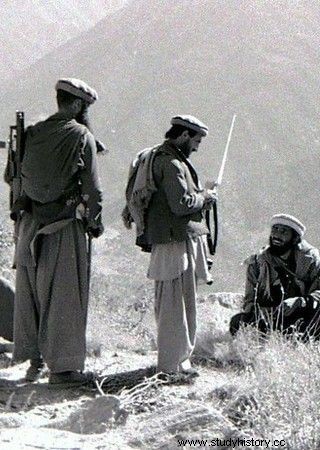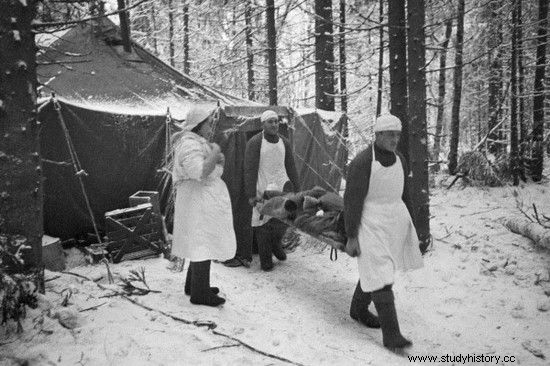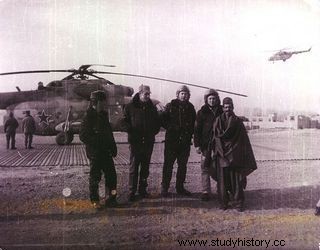Surprisingly, it was not the mujahideen behind every rock that posed the greatest threat to the Soviet soldiers occupying Afghanistan (1979-1989). What was the most common reason for visits to hospitals by soldiers? Infectious diseases that the military health service could not cope with at all.
After entering Afghanistan, the Soviets theoretically took good care of the health of their soldiers. The army organized as many as seven large military hospitals, in addition, in each smaller garrison there was a medical point. It all looked beautiful only on paper, the reality was quite different. According to Rodric Braithwaite, author of the book “Afgańcy. The last war of the empire ”:
More than three-quarters of the soldiers serving in Afghanistan were hospitalized . About eleven percent were injured or maimed. The rest - sixty-nine percent of all those in military service during this war - suffered from serious illness :twenty-eight percent for infectious jaundice, seven and a half percent for typhoid fever, the rest for infectious dysentery, malaria and other diseases.

Contrary to appearances, it was not the mujahideen who posed the greatest threat to the Soviet soldiers occupying Afghanistan (photo:Erwin Lux; license CC ASA 3.0).
Jaundice and cholera put whole divisions
out of the fight
The permanent lack of funds and the outrageous sanitary conditions were to blame for everything. Hospitals faced a chronic shortage of staff, medicines and even bandages. One of the Soviet medics went so far as to say that: If we had what we need, we could save three-quarters of the patients, and yes ...
Sometimes it was the soldiers themselves who were to blame. Apparently, the desperate resorted to methods that still remembered the First World War. In order to avoid line service, they bought urine of people infected with jaundice from paramedics in hospitals. It was enough to drink it to get this serious disease.
As it is easy to predict, the effects did not take long to come. For example, at the end of 1981, every fourth soldier from the 5th Guards Mechanized Division in Shindand was suffering from disease - mainly jaundice. The highest-ranking commanders were also chained to the beds. As reported by Braithwaite including Commander Boris Gromov, his deputies and all regimental commanders were ill at the same time . Of course, in that state, the division was actually unable to fight.

As Rodric Braithwaite notes, the Soviet medical service during World War II was much better at controlling disease than its successors in Afghanistan
However, it was not only jaundice that decimated the ranks of the Soviet Army in Afghanistan. Damn turned out to be no less dangerous. The soldiers of the 66th Separate Mechanized Brigade stationed in Jalalabad were to find out about it in the summer of 1985, when members of one of the patrols returning from the action drank water from a roadside spring. After a few days, three soldiers on roll-call fell to the ground - they were just diagnosed with cholera.

The article is based on the book by Rodric Braithwaite entitled "Afghans" (Znak, 2012)
The disease spread rapidly and eventually more than half of the brigade contracted it. The situation was so dangerous that the sick were isolated behind the barbed wire, doctors and nurses were isolated with them , and the necessary meals - additional medical personnel - had to be brought by planes from Moscow .
Some even argued that to prevent further infection, the corpses of the dead were burned, which was quite a shock to deep down, the still religious Russians.
Conditions did not improve at all after that. It is estimated that throughout the occupation of Afghanistan, as much as a quarter, and possibly even a third, of the 40th Army was excluded from operations due to disease . At the peak of the epidemic, there was only one nurse for three hundred patients.
At least we're better at something
Rodric Braithwaite is inclined to assume that the Soviet medical service during World War II was much better at controlling disease than under its successors.

Soviet troops are withdrawing from Afghanistan. The defeat resulted not only from the fierce resistance of the mujahideen, but also from the completely ineffective military health service (photo:Mikhail Evstafiev; license CC ASA 2.5).
In fact, the only thing that was done better in Afghanistan was the evacuation of victims from the battlefield. This is not surprising, however, as the Soviets did not yet have rescue helicopters during World War II. One optimistic report boasted that:

The only success that the Soviet health service in Afghanistan could boast of was the transport of the wounded by helicopters (photo:E. Kuvakin; license CC ASA 3.0).
nine out of ten wounded soldiers received first aid within thirty minutes and reached the doctor within six hours .
But what of it actually? The reality of the Soviet military hospitals in Afghanistan was that even if the wounded person did not die on the operating table, he had a great chance of dying from infection. This fate befell thousands of soldiers.
Source:
- Rodric Braithwaite, Afghans. The last war of the empire , Znak Publishing House, 2012.
